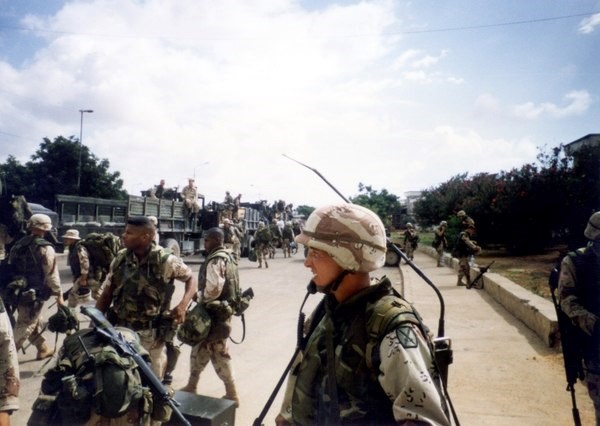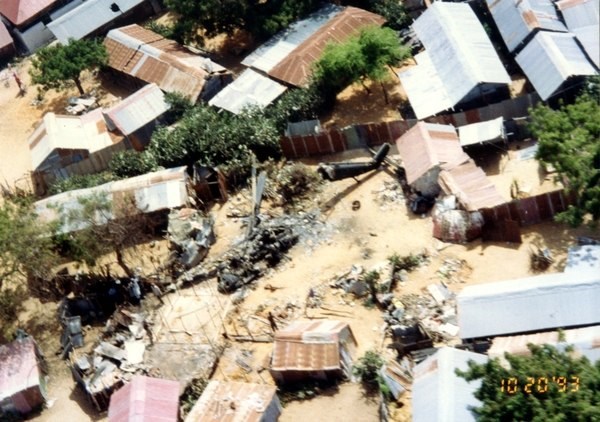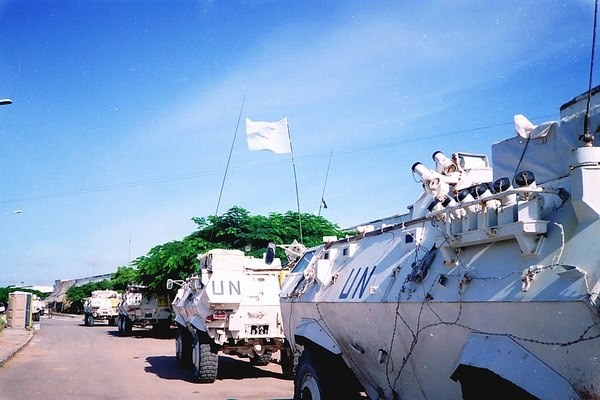Army Times
Sunday March 31, 2019
By Todd South

Soldiers with the 10th Mountain Division in Mogadishu, Somalia in 1993. A new documentary, "Black Hawk Down: The Untold Story," showcases their role in the legendary Battle of Mogadishu. (Randall Larsen)
For more than a quarter century, the story of the Battle of Mogadishu, popularized by both the book and film versions of “Black Hawk Down,” has focused on the Army Rangers and Delta Force team members caught in the worst urban combat the U.S. military had seen since the Vietnam War.
A new documentary tells the story of the 10th Mountain Division soldiers who rescued those Rangers and Delta operators.
“Black Hawk Down: The Untold Story,” is a documentary made by retired Air Force Col. Randall Larsen, who also served in the Army during his 32-year military career. Larsen’s production company previously produced the documentary “Operation Whitecoat,” the story of 2,300 conscientious objectors who volunteered for biological experiments at Fort Detrick, Maryland from 1954 to 1973.
Larsen met now-retired Brig. Gen. Bill David, who commanded 2nd Battalion, 14th Infantry Regiment, 10th Mountain Division during its deployment as a quick reaction force in the Battle of Mogadishu years ago while both were doing advanced academic degrees.
But it wasn’t until last year, as the 25th anniversary of the Oct. 3, 1993 battle approached that Larsen, himself a Vietnam War combat veteran, realized the role that 10th Mountain played in that intense fight.
“As I started peeling the onion and looking into this thing I thought, ‘Oh my God this is an incredible story and I didn’t know it',” Larsen told Army Times. “I’d read the book when it came out. I’d seen the movie. I’d sat in bars with Bill and kind of heard it a little bit.”
So, despite promising his wife he’d retired from filmmaking after the previous documentary, Larsen kicked production into high gear and completed an early version of the film in time for the anniversary last year at Fort Drum, New York, home of the 10th Mountain Division.
The movie was screened for a select audience at the International Spy Museum and the Army Navy Club this week. It is available for presale on Amazon.com and the DVD version, which includes bonus interviews with veterans of the fight and Army Chief of Staff Gen. Mark Milley, will be for sale at Wal-Mart stores beginning in May. It can be live streamed online here.
He said the work was worth it when a veteran of Alpha Company, 2nd Battalion came up to him afterward.
“You know, all these years I’ve been telling my son what I did, and he says, ‘dad, that wasn’t in the movie,’” Larsen said the veteran told him. “My son will finally believe me now.”
David echoed the comment.
“I think this film does a heck of a lot to validate what they’ve been telling their family members for decades now,” the one-star said.
The film opens with the beginnings of Operation Restore Hope, when, in 1992 then-President George H.W. Bush ordered Marines and 10th Mountain Division soldiers to Somalia to secure vast stores of food aid that had been sent to starving citizens caught up in a devastating civil war.
The initial stages were largely successful, reducing famine and fighting. Most of the force was pulled out, except for portions of 10th Mountain and later Task Force Ranger, made up of elements of Delta Force, 75th Ranger Regiment and the 160th Special Operations Aviation Regiment, were tasked with taking down the infrastructure of warlord Mohamed Farrah Aidid, who was escalating fighting among the factions, threatening to plunge the nation into deeper strife.
During a mission to capture some of Aidid’s lieutenants, two UH-60 Black Hawk helicopters were shot down and members of Task Force Ranger were killed while others were pinned down without a way to safely extract the dead and wounded.
What was supposed to be a 30-minute mission that started in mid-afternoon became an all-night shootout to survive.
The first attempt to reach the two crash sites and also find the Rangers and Delta operators was a rapid response by 10th Mountain soldiers in Humvees and open trucks lined with plywood and sandbags.
Retired Delta Force Col. Lee Van Arsdale, a lieutenant colonel at the time with 1st Special Forces Operational Detachment, noted the tactical problems immediately.

A new documentary, "Black Hawk Down: The Untold Story," showcases the role of the 10th Mountain Division in the legendary Battle of Mogadishu.The soldiers went to the two helicopter crash sites to recover equipment and look for survivors. They also rescued the Rangers and Delta operators stranded in the city. (Randall Larsen)
Top Pentagon brass had asked that the units have armor long before the operation but that was denied by then-Secretary of Defense Less Aspin.
“Who goes into combat in an unarmored Humvee in an urban environment? We do,” Van Arsdale said at the screening.
Somali fighters were ready and unleashed barrage after barrage of AK-47 fire and rocket-propelled grenade launcher rounds at the vulnerable vehicles. They’d also created barriers with crushed vehicles and burning tires to funnel the soldiers into choke points for ambush.
They had to withdraw, return to base and refit. Quick calls managed to get Malaysian Armored Personnel Carriers and Pakistani tanks to join the formation from the United Nations peacekeeping force.
But complications ensued. Language barriers and restrictions from those forces’ commanders later meant the APCs, not the tanks, would lead the charge on the second attempt at the sites.
And lack of training with the vehicles became clear for the 10th Mountain soldiers immediately.
“We didn’t even know how to open the doors,” one veteran said in the film.
But they sped back into the city, heading on a new route to the crash sites and stranded comrades. En route, however, two of the APCs were hit with RPGs and drivers were knocked off course, separating those two vehicles, and the soldiers inside, from the rest of the convoy.
The fight continued as the main element continued on, yet was stymied when tank commanders refused to roll through barricades and soldiers had to dismount in the middle of a firefight to remove heaps of trash from the streets so the APCs could get to their objective.
For nearly all of the soldiers, this was their first taste of combat. For the Army it was the most substantial urban fighting since the Battle of Hue City in Vietnam 25 year before.
After block-by-block fighting and house clearing while incoming fire rained from all sides, the 10th Mountain soldiers reached the stranded troops, loaded the wounded onto vehicles and egressed. At the time the “lost platoon” of two vehicles was thought to be dead as they lacked communications for most of the battle with the other element and with headquarters.
But they were able to rejoin the rest of the convoy as dawn was breaking.
The fighting only increased.
One soldier in the documentary said heading into the crash sites he fired one, 30-round magazine. Heading out, he emptied four.

A new documentary, "Black Hawk Down: The Untold Story," showcases the role of the 10th Mountain Division in the legendary Battle of Mogadishu. These are the Malaysian Armored Personnel Carriers used to bring them to the fight. The soldiers went to the two helicopter crash sites to recover equipment and look for survivors. They also rescued the Rangers and Delta operators stranded in the city. (Randall Larsen)
With all accounted for, they made it back to the Pakistani stadium where medical care had been set up. With broken communications, the toll wasn’t clear until many saw the bodies of the fallen and the wounded laid out on stretchers on the field.
Just as the first attempt to reach the Rangers and Delta operators failed, David said he had a flashback to a conversation he’d had years ago in infantry training with a general, in which he was told that he was expendable, but not to “stain the colors of your regiment.”
As that memory flitted through his mind, he made his own resolution.
“I just made my mind up, we’re not going to stain the colors tonight,” he said.
And after the harrowing mission concluded and both his men and the Task Force Ranger troops and the fallen had been recovered, his intent fulfilled.
“I think we did the regiment colors proud that night,” he said in the film.